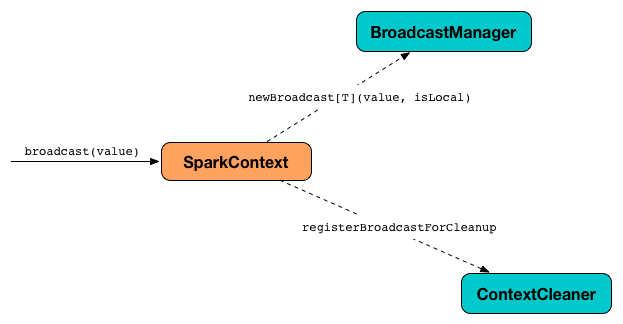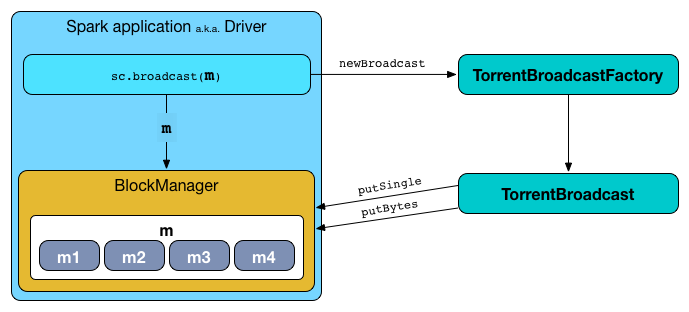Broadcast Variables¶
From the official documentation about Broadcast Variables:
Broadcast variables allow the programmer to keep a read-only variable cached on each machine rather than shipping a copy of it with tasks.
And later in the document:
Explicitly creating broadcast variables is only useful when tasks across multiple stages need the same data or when caching the data in deserialized form is important.

Spark uses SparkContext to create broadcast variables and BroadcastManager with ContextCleaner to manage their lifecycle.

Not only can Spark developers use broadcast variables for efficient data distribution, but Spark itself uses them quite often too. A very notable use case is when Spark distributes tasks (to executors) for execution.
The idea is to transfer values used in transformations from a driver to executors in a most effective way so they are copied once and used many times by tasks (rather than being copied every time a task is launched).
Lifecycle of Broadcast Variable¶
Broadcast variables (TorrentBroadcasts, actually) are created using SparkContext.broadcast method.
scala> val b = sc.broadcast(1)
b: org.apache.spark.broadcast.Broadcast[Int] = Broadcast(0)
Tip
Enable DEBUG logging level for org.apache.spark.storage.BlockManager logger to debug broadcast method.
With DEBUG logging level enabled, there should be the following messages printed out to the logs:
Put block broadcast_0 locally took 430 ms
Putting block broadcast_0 without replication took 431 ms
Told master about block broadcast_0_piece0
Put block broadcast_0_piece0 locally took 4 ms
Putting block broadcast_0_piece0 without replication took 4 ms
A broadcast variable is stored on the driver's BlockManager as a single value and separately as chunks (of spark.broadcast.blockSize).

When requested for the broadcast value, TorrentBroadcast reads the broadcast block from the local BroadcastManager and, if fails, from the local BlockManager. Only when the local lookups fail, TorrentBroadcast reads the broadcast block chunks (from the BlockMannagers on the other executors), persists them as a single broadcast variable (in the local BlockManager) and caches in BroadcastManager.
scala> b.value
res0: Int = 1
Broadcast.value is the only way to access the value of a broadcast variable in a Spark transformation. You can only access the broadcast value any time until the broadcast variable is destroyed.
With DEBUG logging level enabled, there should be the following messages printed out to the logs:
Getting local block broadcast_0
Level for block broadcast_0 is StorageLevel(disk, memory, deserialized, 1 replicas)
In the end, broadcast variables should be destroyed to release memory.
b.destroy
With DEBUG logging level enabled, there should be the following messages printed out to the logs:
Removing broadcast 0
Removing block broadcast_0_piece0
Told master about block broadcast_0_piece0
Removing block broadcast_0
Broadcast variables can optionally be unpersisted.
b.unpersist
Introduction¶
You use broadcast variable to implement map-side join, i.e. a join using a map. For this, lookup tables are distributed across nodes in a cluster using broadcast and then looked up inside map (to do the join implicitly).
When you broadcast a value, it is copied to executors only once (while it is copied multiple times for tasks otherwise). It means that broadcast can help to get your Spark application faster if you have a large value to use in tasks or there are more tasks than executors.
It appears that a Spark idiom emerges that uses broadcast with collectAsMap to create a Map for broadcast. When an RDD is map over to a smaller dataset (column-wise not record-wise), collectAsMap, and broadcast, using the very big RDD to map its elements to the broadcast RDDs is computationally faster.
val acMap = sc.broadcast(myRDD.map { case (a,b,c,b) => (a, c) }.collectAsMap)
val otherMap = sc.broadcast(myOtherRDD.collectAsMap)
myBigRDD.map { case (a, b, c, d) =>
(acMap.value.get(a).get, otherMap.value.get(c).get)
}.collect
Use large broadcasted HashMaps over RDDs whenever possible and leave RDDs with a key to lookup necessary data as demonstrated above.
Demo¶
You're going to use a static mapping of interesting projects with their websites, i.e. Map[String, String] that the tasks, i.e. closures (anonymous functions) in transformations, use.
val pws = Map(
"Apache Spark" -> "http://spark.apache.org/",
"Scala" -> "http://www.scala-lang.org/")
val websites = sc.parallelize(Seq("Apache Spark", "Scala")).map(pws).collect
// websites: Array[String] = Array(http://spark.apache.org/, http://www.scala-lang.org/)
It works, but is very ineffective as the pws map is sent over the wire to executors while it could have been there already. If there were more tasks that need the pws map, you could improve their performance by minimizing the number of bytes that are going to be sent over the network for task execution.
Enter broadcast variables.
val pwsB = sc.broadcast(pws)
val websites = sc.parallelize(Seq("Apache Spark", "Scala")).map(pwsB.value).collect
// websites: Array[String] = Array(http://spark.apache.org/, http://www.scala-lang.org/)
Semantically, the two computations - with and without the broadcast value - are exactly the same, but the broadcast-based one wins performance-wise when there are more executors spawned to execute many tasks that use pws map.